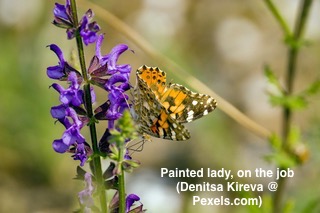By Terry Deem-Reilly, CSU Extension – Denver Master Gardener since 2003
In January, Governor Polis, in collaboration with the Colorado Department of Natural Resources (DNR), the Colorado State University Extension, the Xerces Society for Invertebrate Conservation, and the University of Colorado Museum of Natural History, released the Colorado Native Pollinating Insects Health Study. This report was commissioned by the state legislature through the passage of SB99-22 and is the most detailed scientific study ever made of Colorado pollinators.

Contents
This document is not only big historically and scientifically but also literally big, running to 273 pages that include an impressive list of citations and appendices that are worth exploring on their own. Most of the information cited comes from “peer-reviewed professional publications,” supplemented by academic and governmental research and publicly available data from databases, government agencies, and biodiversity data aggregators.
The length of the report renders a complete condensation into a blog post impossible, but I’ll attempt to outline the major sections and review the main features of interest for our CMG Blog fans.
The report is divided into an executive summary, four subject sections, the appendices, and the citation list. I’ll name and briefly summarize each of these below to (I hope!) direct readers to the pages of greatest interest.
- The Executive Summary explains the rationale and structure of and intended audience for the report. There are summaries of Sections 1 through 4 that nicely describe the contents of these sections and furnish an extremely helpful quick reference. You’ll find this section readable and informative.
- Section 1, Introduction, describes the background, participants, stakeholders and intended audiences, and organization of the report.
- Section 2, Scientific Review of Colorado Native Pollinating Insects, discusses the importance and decline of and research on Colorado pollinators and conservation practices for pollinators and their habitats.
- Section 3, Conservation Practices for Pollinating Insects and Their Habitat, presents considerations and practices for conservation and management and federal and state agency programs, policies, and recommendations.
- Section 4, Future Priorities for Pollinating Insect Health & Management, lists five priorities for insect health and management, actions and resources to address those priorities, and a brief discussion of conclusions based on the data presented in Sections 2 through 4.
- Appendix I, Glossary of Terms, includes precise definitions of the vocabulary in the report, and a list of acronyms. (Some terms may be quite new to many readers.)
- Appendix II, Potential Pollinator Partners & Collaborators, lists names of and links to agencies and organizations that offer guidance on pollinators and pollinator conservation.
- Appendix III, Distributions of Colorado Bumble Bees, shows the distribution and range of all 24 bumble bees native to Colorado.
- Appendix IV, Imperiled Pollinator Profiles, contains “profiles of ESA-listed, candidate, and proposed threatened pollinator species found in Colorado, as well as declining pollinators that have the potential to be listed in the future based on NatureServe rankings and expert opinion.” (“ESA” refers to the federal Endangered Species Act.) A photograph of each species is included.
- Appendix V, Information Available Upon Request, shows how to contact CSU Extension or the Xerces Society for a copy of the survey administered to state and federal agency staffs.
- Literature Cited lists the articles from scientific journals and the research compiled by academic institutions that were used in writing the report. Warning: some links have gone rotten or connect the readers to databases like ProQuest that limit access to subscribers only. To access these articles, contact your local library to see if they are available in its catalog or databases or through interlibrary loan (ILL).

Some Caveats
This report was compiled to assist state government agencies and land managers in understanding and combatting pollinator collapse; it was not intended as a guide for hobby gardeners or other members of the private sector. However, there’s a wealth of scientific data and expert observation in this study, and careful reading of the data and recommendations will give readers a leg up in making their own plans for supporting our endangered pollinators.
Some links in the list of citations have gone rotten or connect the reader to databases like ProQuest that limit access to subscribers only. To access these articles, contact your local library to check their availability in its catalog, databases, or through interlibrary loan (ILL).
And a little extra…
For help in creating your own pollinator heath program, visit the DNR’s ‘Native Pollinating Insects Health Study’ page and use the links for expert information on identifying and protecting these indispensable members of our ecosystem.






























